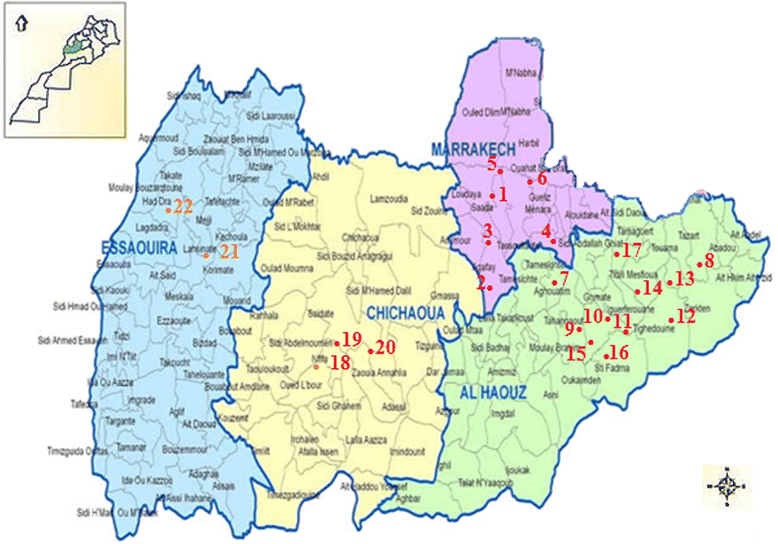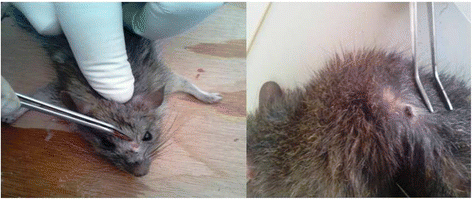Molecular detection of Leishmania infantum and Leishmania tropica in rodent species from endemic cutaneous leishmaniasis areas in Morocco
- PMID: 28969710
- PMCID: PMC5625640
- DOI: 10.1186/s13071-017-2398-8
Molecular detection of Leishmania infantum and Leishmania tropica in rodent species from endemic cutaneous leishmaniasis areas in Morocco
Abstract
Background: Leishmaniasis remains a major public health problem in African nations, including Morocco, where little is known about the vertebrate reservoirs involved in the causal parasites' transmission cycles. The present study investigates the role of rodent species as potential reservoirs of Leishmania spp. in central Morocco, where both L. tropica and L. infantum have been reported.
Methods: Rodents were caught from 22 sites in central Morocco, by using Sherman metal traps, and identified morphologically. For each specimen, genomic DNA was extracted from different tissues using the Speed Tools DNA extraction Kit. Then, samples were PCR-analyzed, targeting the SSU rRNA gene to detect Leishmania spp. DNA, followed by amplification of the internal transcribed spacer 1 (ITS1) and its sequencing to identify the species.
Results: A total of 197 rodents belonging to ten species were captured and identified: Rattus rattus (40.61%), Mus musculus (25.38%), Apodemus sylvaticus (8.63%), Mus spretus (7.11%), Meriones shawi (5.58%), Rattus norvegicus (4.57%), Meriones libycus (3.05%), Mastomys erythroleucus (2.03%), Gerbillus campestris (2.03%) and Lemniscomys barbarus (1.01%). Molecular analysis revealed the presence of Leishmania species in 18 specimens: six R. rattus (out of 80 captured; 7.5%), 11 M. musculus (out of 50 captured; 22%), and one R. norvegicus (out of 9 captured; 11.11%).
Conclusions: To the best of our knowledge, L. infantum and L. tropica were identified in rodent species for the first time in Morocco. These findings suggest that rodent species may be involved in L. infantum and L. tropica transmission cycles in this country but that further studies are needed to confirm their role as reservoirs of Leishmania species in Morocco.
Keywords: ITS1 PCR; L. infantum; Leishmania tropica; LnPCR; Morocco; Rodents.
Conflict of interest statement
Ethics approval and consent to participate
All animals were treated according to European decree NOR: AGRG1238767A (1st February 2013) regarding the ethical evaluation and authorization of projects involving animals for experimental procedures. All efforts were made to minimize the suffering of the animals used.
Consent for publication
Not applicable.
Competing interests
The authors declare that they have no competing interests.
Publisher’s Note
Springer Nature remains neutral with regard to jurisdictional claims in published maps and institutional affiliations.
Figures
Similar articles
-
Molecular detection of Leishmania infantum in wild rodents (Rattus norvegicus) in Greece.Zoonoses Public Health. 2010 Dec;57(7-8):e23-5. doi: 10.1111/j.1863-2378.2009.01264.x. Zoonoses Public Health. 2010. PMID: 19912600
-
Molecular identification of Leishmania tropica and L. infantum isolated from cutaneous human leishmaniasis samples in central Morocco.J Vector Borne Dis. 2020 Jan-Mar;57(1):71-77. doi: 10.4103/0972-9062.308804. J Vector Borne Dis. 2020. PMID: 33818459
-
First molecular detection and identification of Leishmania species in small wild rodents from Turkey.Parasitology. 2020 Sep;147(10):1088-1093. doi: 10.1017/S0031182020000803. Epub 2020 May 14. Parasitology. 2020. PMID: 32404216 Free PMC article.
-
The current status of cutaneous leishmaniasis in Morocco.Turkiye Parazitol Derg. 2014;38(1):5-8. doi: 10.5152/tpd.2014.1401. Turkiye Parazitol Derg. 2014. PMID: 24659693 Review.
-
Cutaneous leishmaniasis in North Africa: a review.Parasite. 2014;21:14. doi: 10.1051/parasite/2014014. Epub 2014 Mar 14. Parasite. 2014. PMID: 24626301 Free PMC article. Review.
Cited by
-
High-resolution melting analysis identifies reservoir hosts of zoonotic Leishmania parasites in Tunisia.Parasit Vectors. 2022 Jan 8;15(1):12. doi: 10.1186/s13071-021-05138-x. Parasit Vectors. 2022. PMID: 34996507 Free PMC article.
-
First Report of Two Jaculus Rodents as Potential Reservoir Hosts of Leishmania Parasites in Tunisia.Microorganisms. 2022 Jul 25;10(8):1502. doi: 10.3390/microorganisms10081502. Microorganisms. 2022. PMID: 35893560 Free PMC article.
-
Occurrence of Leishmania infantum in Wild Mammals Admitted to Recovery Centers in Spain.Pathogens. 2023 Aug 16;12(8):1048. doi: 10.3390/pathogens12081048. Pathogens. 2023. PMID: 37624008 Free PMC article.
-
Ecology and seasonality of sandflies and potential reservoirs of cutaneous leishmaniasis in Ochollo, a hotspot in southern Ethiopia.PLoS Negl Trop Dis. 2019 Aug 19;13(8):e0007667. doi: 10.1371/journal.pntd.0007667. eCollection 2019 Aug. PLoS Negl Trop Dis. 2019. PMID: 31425506 Free PMC article.
-
Transmission patterns of Leishmania tropica around the Mediterranean basin: Could Morocco be impacted by a zoonotic spillover?PLoS Negl Trop Dis. 2022 Jan 13;16(1):e0010009. doi: 10.1371/journal.pntd.0010009. eCollection 2022 Jan. PLoS Negl Trop Dis. 2022. PMID: 35025884 Free PMC article. Review.
References
-
- Lainson R, Shaw JJ. Evolution, classification and geographical distribution. In: Peters W, Killick-Kendrick R, editors. The Leishmaniasis in Biology and Medicine. London: Academic Press; 1987.
-
- Pesson B, Ready JS, Benabdennbi I, Martin-Sanchez J, Esseghir S, Cadi Soussi M, et al. Sand flies of the Phlebotomus perniciosus complex: mitochondrial introgression and a new sibling species of P. longicuspis in the Moroccan Rif. Med Vet Entomol. 2004;18:25–37. doi: 10.1111/j.0269-283x.2004.0471.x. - DOI - PubMed
MeSH terms
Substances
LinkOut - more resources
Full Text Sources
Other Literature Sources
Miscellaneous



